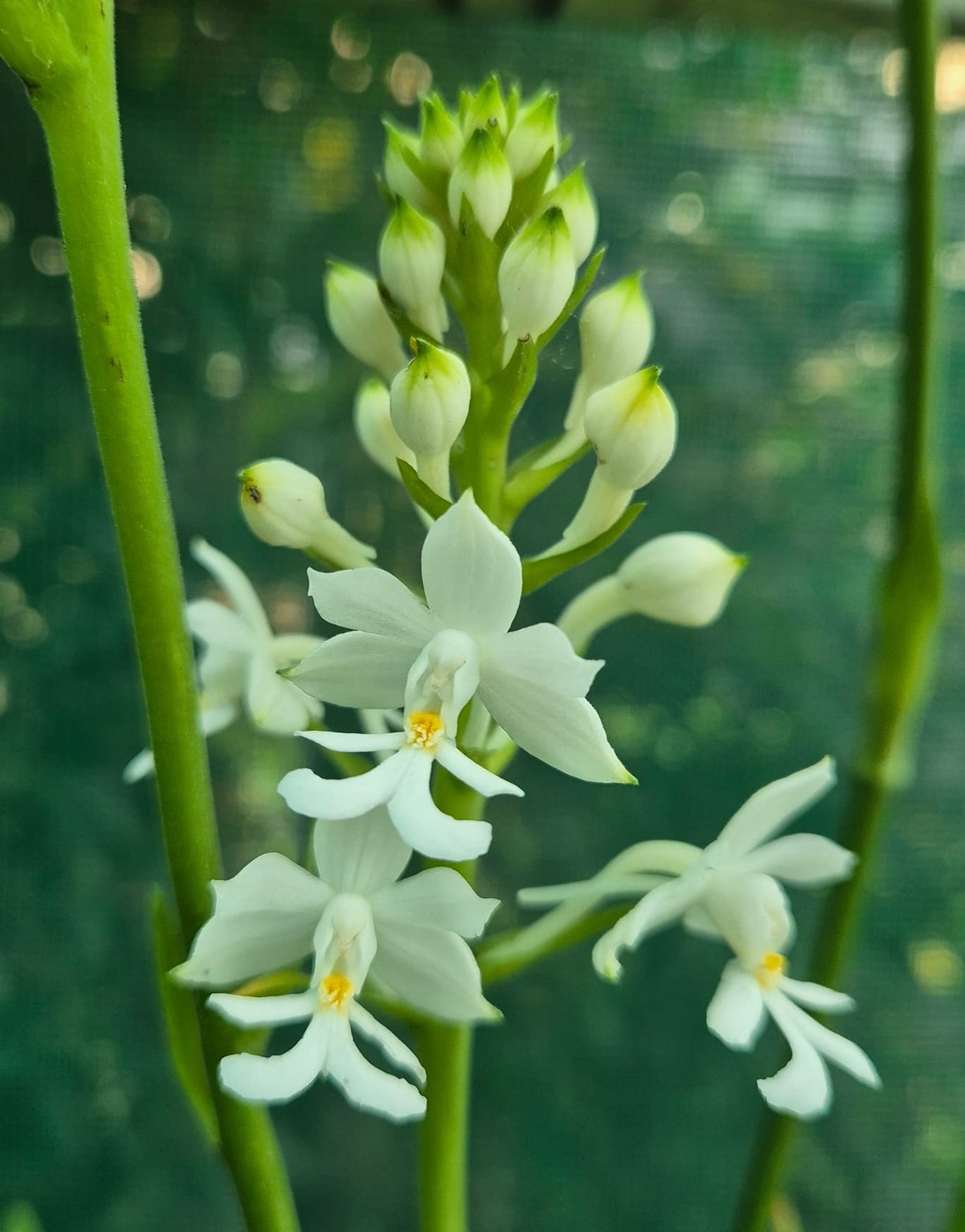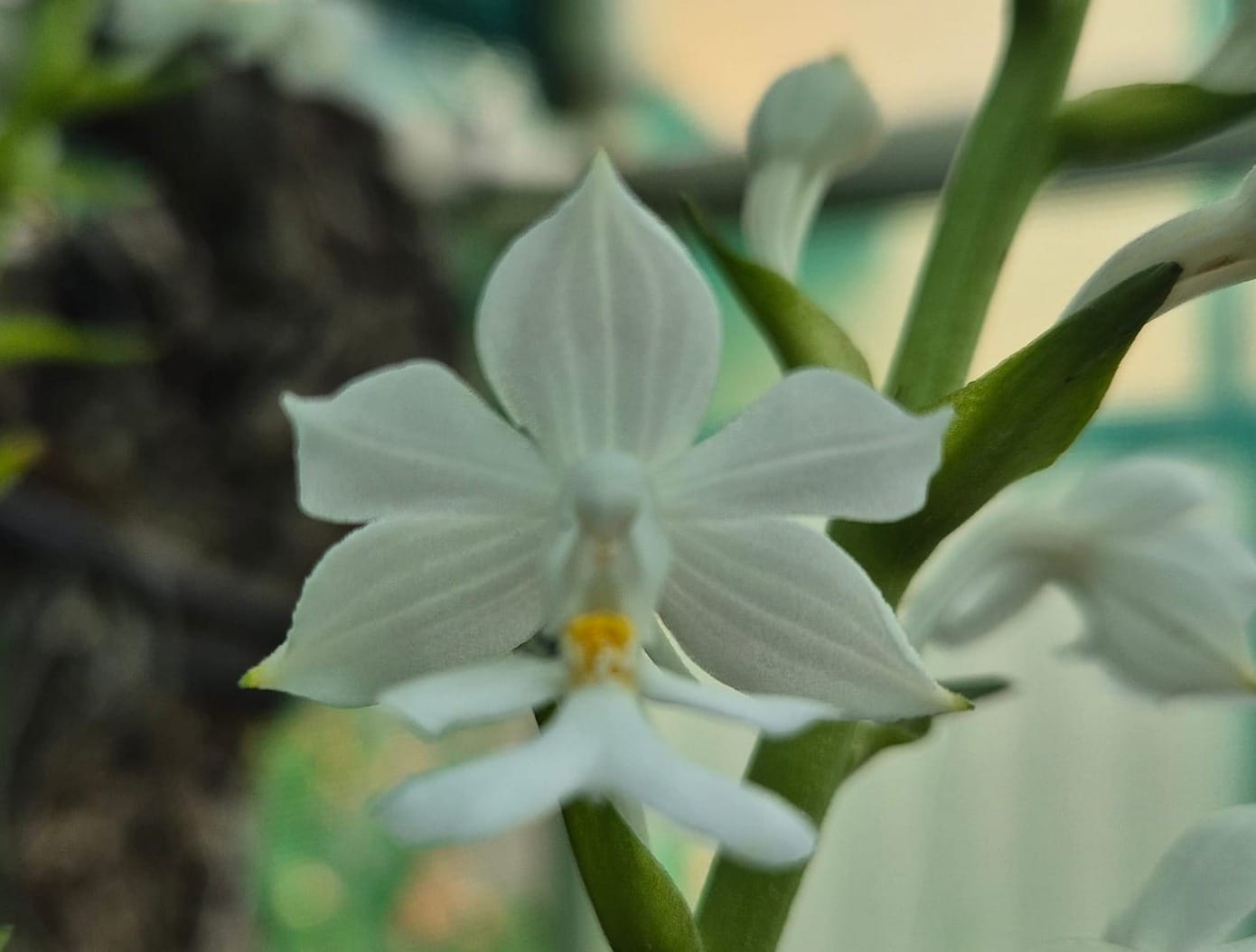Calanthe triplicata Care: Complete Growing Guide for the Australian Christmas Orchid

Calanthe triplicata is often called the Christmas Orchid in Australia because it often blooms during the holiday season (mid summer) in the southern hemisphere With its elegant white flowers cascading down graceful stems, this terrestrial orchid is a stunning addition to any garden and in fact was one of the first orchids I ever owned.
While this beauty has some specific needs that differ from standard care for Cymbidiums or Cattleyas, it's actually one of the more forgiving terrestrial orchids to grow! Let's jump into everything you need to know to successfully grow and care for your Calanthe triplicata.
Understanding Calanthe triplicata: Natural Habitat and Characteristics
Calanthe triplicata, is a relatively widespread species native to a vast region stretching from tropical and subtropical Asia to the Pacific islands and down the east coast of Australia to at least southern Sydney. In its natural habitat, this terrestrial orchid thrives in the dappled shade of moist forest floors.
The orchid features distinctive pleated leaves that can grow up to 60cm long, creating an attractive fan-like appearance they look like less robust Gymea Lilies. These leaves emerge from pseudobulbs, forming dense clumps over time. The foliage is evergreen in tropical conditions but is easily damaged and may be discolured or even semi deciduous in cooler climates.
Most striking are the flower spikes, which can reach heights of 3 feet or more. Each spike produces numerous pure white flowers, typically blooming from late December through January – hence its festive common name. The flowers themselves are about 1 inch across and pure white with a small spot of yellow through orange/red at the base of the lip.

In its natural environment, Calanthe triplicata experiences consistent humidity, protected shade, and is often found adjacent seasonal streams, all factors that must be taken into account for successful cultivation
Essential Growing Conditions for Christmas Orchid Success
The key to successfully growing Calanthe triplicata lies in replicating its natural forest understory conditions. Light is perhaps the most critical factor – these orchids require bright, filtered shade to partial shade. Direct sunlight can quickly damage the leaves, while too little light will prevent blooming and lead to long soft lanky growth prone to insect attack.
Optimal light conditions can be achieved by:
- Placing plants under 70-80% shade cloth in an orchid house
- Providing morning sun only, with protection from afternoon heat under a pergola or similar
- Growing it in the garden in ground or in a pot under a desiduous tree that forms a thick summer canopy.
Temperature preferences fall in the moderate range, with ideal conditions being:
- Daytime temperatures between 65-80°F (18-27°C)
- Night temperatures no lower than 55°F (8°C)
- Protection from frost is essential
- A temperature drop of 5-10°C at night can help trigger blooming
Humidity should be maintained between 50-70%. In drier environments, this can be achieved through:
- Regular misting
- Use of humidity trays
- Running a humidifier
- Grouping plants together
Air circulation is crucial but should be gentle to avoid drying out the plants. Use fans if needed, but never direct them straight at the orchids. The thin leaves of this plant are particularly prone to drying out in hot dry windy weather
Soil and Potting Requirements
Calanthe triplicata requires a well-draining yet moisture-retentive growing medium that mimics the rich forest floor conditions of its natural habitat. The ideal potting mix should contain:
- 50-60% fine-grade orchid bark
- 20% peat moss or coco coir
- 20-25% perlite
- A handful of horticultural charcoal
When selecting containers, choose pots that are:
- 5cm or so larger than the root ball
- Made of plastic or glazed ceramic to retain moisture
- Equipped with adequate drainage holes
- Deep enough to accommodate the extensive root system
Repotting should be performed every 2-3 years, or when:
- The plant outgrows its container
- The growing medium begins to break down
- After the flowering season has ended
- Before new growth begins in spring
Root care is essential during potting and maintenance:
- Trim any dead or rotting roots
- Keep roots moist but not waterlogged
- Avoid disturbing healthy roots during maintenance
- Treat any cuts with fungicide to prevent infection

Watering and Fertilization Guide
Proper watering is crucial for Calanthe triplicata's health and blooming success. These orchids prefer consistent moisture but cannot tolerate waterlogged conditions.
Watering Schedule:
- Growing season (spring-summer): Water thoroughly when the top inch of medium feels dry. Grow plant in 1-2cm deep saucer.
- Rest period: Maintain light moisture even during dormancy
- Morning watering is preferred to allow excess moisture to evaporate and make sure you water sufficiently to flush the pot and saucer and avoid stagnant water.
Water Quality Requirements:
- Use room temperature water where possible
- If using tap water, let it sit overnight to dissipate chlorine
- Rainwater or filtered water is ideal
Fertilisation:
- Use balanced orchid fertilizer (20-20-20)
- Feed weekly during growing season at half or quarter strength
- Monthly feeding during winter months
- Flush the potting medium monthly to prevent salt buildup using straight water and watering about 4-5 times the volume of the pot.
Blooming and Flower Care
Calanthe triplicata's blooming period is one of its most distinctive features, typically occurring during the mid summer months.
Encouraging Blooms:
- Ensure adequate light levels during growing season
- Maintain temperature differential between day and night
- Keep humidity consistent during bud development
Flower Spike Care:
- Support tall spikes with stakes if needed though they tend to be fairly upright.
- Avoid moving plant once buds form
- Keep flowers away from heat sources and cold drafts
- Remove damaged or diseased buds promptly
Post-bloom care is crucial for future flowering:
- Remove spent flower spikes at the base
- Continue regular care routine
- Continue fertilising as new growth appears
- Monitor for signs of stress after flowering
Troubleshooting Common Problems
Like all orchids, Calanthe triplicata can face various challenges, but most are preventable with proper care.
Common Pests:
- Spider mites: Particularly common when plants are grown in low humidity areas including inside. Treat with insecticidal soap or neem oil.
- Scale insects: Remove manually with a toothbrush and rubbing alcihol and treat with horticultural oils.
- Mealybugs: This has been the most common pests on these plants for me where the mealy bugs hide deep in the leaf axels. Isolate affected plants and treat with alcohol swabs.
- Slugs and snails: another common one as the soft leaves are particularly attractive. Use appropriate baits or barriers.
Disease Prevention:
- Root rot: Avoid overwatering and ensure good drainage
- Leaf spot: Improve air circulation and avoid water on leaves
- Bacterial infections: Remove affected parts and treat with copper fungicide
Propagation Methods and Tips
Calanthe triplicata can be propagated easily through division. Some say it can also be propagated by flower stem cuttings similar to Phaius tankervillleae but I have had many attempts without any success.
Division Process:
- Wait until the plant has at least 6-8 healthy pseudobulbs
- Divide after flowering but before new growth begins
- Use sterile tools to separate pseudobulbs, they grow very close together and are comparatively delicate so cutting is preferable to pulling apart in this instance.
- Ensure each division has at least 2-3 pseudobulbs
- Treat cut surfaces with fungicide or cinnamon powder.
Care for Divisions:
- Pot immediately in fresh growing medium
- Maintain higher humidity during establishment
- Reduce fertiliser until new growth appears
- Protect from stress for first few months
Success Rates:
- Division success rate can be relatively high with proper care
- Expect blooming in 1-2 years after division
- Larger divisions establish more quickly
- Monitor for signs of stress during first month
Growing Calanthe triplicata can be an incredibly rewarding experience, especially when those pristine white blooms emerge during the festive months! Remember that success with this orchid comes down to replicating its natural habitat - providing dappled shade, consistent moisture, and well-draining soil. Start with these fundamentals, and you'll be well on your way to enjoying this orchid's stunning displays.
Why not give it a try? Your garden or home could be graced with these beautiful blooms next Christmas season!

Member discussion